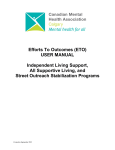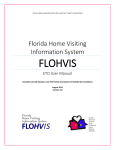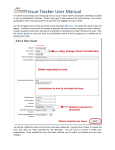Download Efforts To Outcomes (ETO) USER MANUAL Community Transitions
Transcript
Efforts To Outcomes (ETO) USER MANUAL Community Transitions Team: Peer Options, Continuing Connections, and Leisure Recreation Programs Created in September 2012 TABLE OF CONTENTS Introduction 3 Navigating ETO 4 Recording a new client in Waitlist (PO) or Actual Program (Cont. Connections) 5 Editing client information 9 Participant Dashboard Feature 9 View Pending Referrals feature – Peer Options Program only 10 Enrolling client in your Program 13 Printing a Facesheet of your client 14 Dismissing a client from your Program 15 Matching a Volunteer to a client – Continuing Connections Program only 17 Recording your individual time with a client 20 To do List 26 Editing your records (Efforts) 28 Reviewing your client’s efforts including their attendance in groups 30 Recording your time not related to clients 32 Recording assessments linked to a client (Participant Assessments) 34 Recording surveys not linked to a client 38 Adding Groups and Registering clients in your Program’s groups 39 Adding/Removing Groups in the Leisure Recreation Program 43 Adding/Removing Volunteers in your Groups 44 Recording and editing group attendance of registered clients – Peer Options and Continuing Connections 45 Recording group attendance of unregistered clients – Leisure Recreation 48 Un-registering clients in groups – Peer Options and Continuing Connections 49 Logging off 51 2 INTRODUCTION Welcome to ETO! ETO is a case management software for social services developed and maintained by the company Social Solutions based in Baltimore, United States. ETO helps nonprofit organizations quickly and easily track efforts (Staff and Client activities), outcomes (surveys and questionnaires), and the progress of clients in their efforts. To access the ETO database, type in the following address: http://cmhacalgary.etosoftware.ca Your Username is your CMHA e-mail address (or if you don’t have one, use your personal e-mail address that you provided to CMHA). Once you are given an initial password, the new password that you will set up will be of your own choosing, but it has to have a minimum of 6 characters and include at least one numeric character. Peer Options and Leisure Recreation Program Staff have access to their own Programs as well as all the Supportive Living and Outreach Services Programs. This will allow for continuity and seamlessness of services between the Programs. Continuing Connections Program Staff have access to their Program, as well as the Peer Options and Leisure Recreation Programs. The Peer Options Program has a Waitlist Program and the vast majority of clients will first be in this Program and then enrolled in the Actual Peer Options Program when they have been accepted The Continuing Connections Program and the Leisure Recreation Program do not have a Waitlist Program. The Leisure Recreation Program will only ‘enroll’ (and not ‘add’) clients because all of their clients are already or have been in a CMHA Program. There are a lot of common elements among your Programs, which is why only one Manual has been developed for all your Programs. However, the differences between your Programs are taken into consideration and are highlighted. One of the main distinctions of the Leisure Recreation Program is that it does not have registered clients in their groups; attendance is taken for the clients who are registered in the Leisure Recreation Program. Please contact your ETO Administrator (CMHA Outcomes Measurement Coordinator or Director of Client Services in the absence of the Outcomes Measurement Coordinator) if you have any questions regarding ETO. You can also access the Help section in the database, or you can contact the ETO customer support at [email protected] or at 1- 866.732.3560 extension 2 Best wishes for your successful use of ETO! 3 NAVIGATING ETO There are a variety of ways to move through ETO Software. 1 My Dashboard 2 Quick Tab Navigation 3 Custom Home Page Links 4 Navigation Bar It's up to you to decide which navigation method is the most comfortable based on your use of ETO. The ETO Administrator may prefer a method or combination of methods and train you accordingly. Follow the links below to learn more about each. My Dashboard My Dashboard includes details of the work you have recently entered into ETO (Efforts, Assessments, Referrals). It may also include My Caseload, a search feature, reports, etc. Quick Tab Navigation The green tabs across the top of the screen are referred to as Quick Tabs. Quick Search is the most frequently used tab. Enter in a Participant's First or Last Name into the "Enter Search Term(s)" box and click the Search button. Click on a name in the search results to access a list of features to work on with that Participant. 4 Custom Home Page Links Links to features can be added to the Home Page by the ETO Administrator. Navigation Bar The green bar on the right side of the page is referred to as the Navigation Bar. Click on any of the headers (in white font) to access features that fall in that section. RECORDING A NEW CLIENT IN WAITLIST (PO) OR ACTUAL PROGRAM (Continuing Connections Program) Participant – Member of the target population, recipient of service. For CMHA: Participant = registered client. Participant in the context of ETO: “Most of our participants will go through the same process, beginning with an intake and finishing with an exit interview.” 5 Search ETO first to avoid Duplicates! Searching is probably the most frequently used functionality in ETO Software. Before a new Participant is added to the system, it is recommended that the system is searched to avoid duplicate entries Quick Search Quick Search allows you to search for active Participants in the selected program, or those who are active and dismissed across the entire site. Ensure that you select ‘CMHA Calgary Region’ when you do the search. ***Brand new clients = not a CMHA client that is, a self-referral or an external referral*** After you have searched ETO and did not find the client, you will have to Add the brand new client. Add - Entry of data that is not already existing in the database (e.g.: Add Participant, Add Referral, Add Reliable Contact, Add Participant Match) To add a Participant: - Click on Go next to ‘Add Participant’ on the Intake Program’s Home Page, or - Click on ‘Participants’ and then on ‘Add New Participant’ on your Navigation Bar to the right This page will appear. The Add New Participant screen is how a record is started for a participant within the selected program. After this screen is submitted, additional types of data, such as Assessments, Efforts (Points of Service), and Referrals, can be attached to the record. The Demographics seen on this screen are a combination of Standard fields that come with the software, and Custom fields that were set up based on our organization's needs. Custom Demographics can be edited by the ETO Administrator; Standard Demographics are hard coded and cannot be modified. Demographics may vary from program to program, although some fields (including all Standard Demographics 6 and all Custom Demographics built with the Scope of Site), will appear in all programs. Data Entry: Use the tab key or the mouse/track pad to move from field to field Asterisks (and yellow) indicate which fields are required (when a field is required, the user will not be able to submit the record without completing the required information). Do not use the back button or enter keys Understanding Demographic Fields: “Case Number” is automatically generated after the demographic page is submitted/saved. Phone numbers require 10 digits. Enter 10 digits, move to another field, and the number will auto-format with parenthesis and a dash. Postal Code will auto-populate city and province after the page is submitted. The Standard Demographics Referral Source and Funding Source are both a special type of field called Entity Cross Reference. New options can be added through the Add New Entity feature. Select the corresponding Entity Type (Referral Source or Funding Source) based on the field you're populating. If there are Entities in other programs in the site that should be listed in the current program, they can be brought into the program through Enroll Entity. The Alert field (if enabled) will generate a pop-up with the data entered in that field when the participant is accessed through View/Edit Participant, Participant Efforts and Enroll Participant. Submitting the Add New Participant Page: Once you’ve completed all relevant demographic information on the first page, select the Participant’s Program Start Date at the bottom of the page. This date should be the date when the Participant started receiving services or completed an intake form. The Program Start Date can be backdated as necessary. Only the ETO Administrator can edit this date, please enter it carefully. This date default to blank. The Enroll in Program check box must be checked to enroll the participant in the program. The box will be automatically selected. If this box is not checked, the Participant will exist in ETO with no program affiliation. You will then have to use the Enroll Participant feature to pull the participant into the selected program. We would like to avoid this. Click Submit at the bottom of the page to save the record. A confirmation will appear to let you know that the Participant has been successfully added to the Program. Click OK to move to the next screen, which is defined by the ETO Administrator on a program by program basis. Duplicate Alert If you submit the new Participant’s name and it matches another Participant in the Software, you will get a Resolve Potential Duplicates alert. It is very common for staff to be confused by this message, as it is not expected! A list of possible matches of existing records will appear. The Duplicate Alert includes the following options: 7 1. If not a duplicate: Click on Not a duplicate, please add which will add the participant as a new record 2. If a duplicate: Click on Go Back to the demographics and edit the record you are trying to add so that it will no longer match an existing record. If a duplicate is already enrolled in the program, the record will say Currently Enrolled in green. If a duplicate is not enrolled in the program (but exists in the CMHA-Calgary Region site), click on the enroll option: this will redirect you to the Enroll Participant feature, where you will need to search for the Participant. If participant records are duplicated, it's not the end of the world! The records can be merged by the Site Administrator with the Duplicated Participants feature. After submitting the Add New Participant page, you will be directed to another page, based on how your ETO Administrator has customized your system using either feature. 8 EDITING CLIENT INFORMATION Feature to use: View/Edit Participant View/Edit Participant is a program specific search; you can search for both active and dismissed participants. When you have done the search, click on a Participant to view his demographics, and make changes if necessary. To View/Edit Client Information: - Click on Go next to View/Edit Participant on your Program’s Home Page, or - Click on ‘Participants’ and then ‘View/Edit Participant’ on your Navigation Bar. View and/or edit the information and then click on ‘Submit’ PARTICIPANT DASHBOARD FEATURE The Participant Dashboard is a link to have quick access to your client’s file. To access your client’s dashboard, do a quick search and then click on the client’s name and on the client’s dashboard. This is a Participant Dashboard. Through this dashboard, you can view your client’s demographic information as well as his/her recent activities/attendances and assessments (tests). 9 VIEW PENDING REFERRALS FEATURE – PEER OPTIONS PROGRAM ONLY This feature is in the case a CMHA Staff has made a referral for a client to the Peer Options Wait list program. On the Peer Options Waitlist Program Home Page, click on ‘View Pending Referrals’ This page will appear. Always click on ‘A different program within my site’ and then ‘Submit’. 10 A list of clients referred from CMHA Programs to the Peer Options Wait list Program will appear: If you click on ‘Accepted’, this page will appear and you will be able to input the date the client started in the Peer Options Wait List Program, and then click ‘Add to the Program’. This will automatically enroll the CMHA client from another Program to the Peer Options Waitlist Program. 11 If you click on ‘Not Accepted’, this box will appear and you need to select the appropriate reason for nonacceptance and then click on submit. After you have accepted or not accepted a client in the Peer Options Program, you will need to dismiss this client from the Peer Options Waitlist: - For not accepted clients: As soon as the client has not been accepted. - For accepted clients: Once the client is no longer on the waitlist and the Art of Friendship group will start (Clients can stay in the Peer Options waitlist program until the group starts). Refer to the section in this manual with regards to dismissing (discharging) a client. 12 In the case of accepted clients, you will also need to enroll them in the actual Peer Options program – Refer to the section below in this manual. ENROLLING CLIENT IN YOUR PROGRAM The Enroll feature is typically used in one of three scenarios: 1. A previously dismissed participant is returning to the program for services – Relevant to Leisure Recreation, Continuing Connections, and Peer Options Waitlist (in case the individual was never a CMHA client in another Program but was in Peer Options before). 2. A participant is (or has) been enrolled in another program, and now needs to be enrolled in the selected program, too. – Relevant to Leisure Recreation Program 3. A participant is in the Peer Options Wait List, and now needs to be enrolled in the actual Peer Options Program. Enroll – To bring a participant that exists in ETO into the selected program and enter a program start date. Enroll in the context of ETO: Fred got services here three years ago and moved to Florida. When he returned, rather than adding him as a new Participant in ETO, I enrolled him. Feature to use: Enroll Participant On your Navigation bar: Go to ‘Participants’ and then click on ‘Enroll Participants’ or, Click on ‘Go’ next to ‘Enroll Participant’ on your Program’s Home Page. The search function allows you to search for Participants by Last Name, First Name, SSN, Case Number or Family Name. To see a list of all Participants available for enrollment in the selected program, leave the search boxes empty and click Go. Participant Results are grouped into sets of 50. Select the desired participants (click Next 50 to advance to the next 50 results). 13 The page above will appear. Put a checkmark in front of the participant’s name you are interested in. Input the Program Start Date when this page appears: PRINTING A FACESHEET OF YOUR CLIENT Click on ‘Go’ next to ‘View/Edit Participant’ on your Program’s Home Page Search for the client you are interested in. At the bottom of the demographic page click on ‘Participant Face Sheet’ and print the Face Sheet. 14 DISMISSING A CLIENT FROM YOUR PROGRAM Dismiss = Discharge, file closing. Feature to use: Dismiss Participant When a Participant is no longer being served by a selected program, it may Dismissed from that program using this feature. Dismissed participant records are not deleted; a dismissed Participant may be reenrolled with the Enroll Participant feature at any time. Enrollment and dismissal details are stored on the Program History accessed via the button in the upper left of the View Edit or Find Participant pages. Click on Go next to ‘Dismiss Participants’ on your Program’s Home Page. This page will appear 15 Search by the (single or combined) full or partial last name and/or full or partial first name. This page will appear: Put a checkmark next to the client’s name and click on Dismiss (Different Dates + Reasons). This page will appear: Input the End Date, select the dismissal reason, and put a checkmark in ‘Successfully completed’ if the client successfully completed your Program. 16 These are the dismissal reasons: - Completed Service, no follow-up: To be used when the client has successfully completed the Program. - Completed Service, client went to other Program: To be used when the client has successfully completed your Program and is transferring to another CMHA Program or to another Program in the community - Client withdrew from Service - Transfer into the Program: ***This is only to be used by the Peer Options Waitlist Program when an individual is dismissed from the Peer Options Waitlist Program, is accepted, and is moving into the Actual Program*** - Client Moved: When client left the program because is moving to another city. - Client Deceased - Other After dismissing a client, you will need to complete: The Discharge Information Assessment (without housing item). This is a Participant Assessment – Refer to the appropriate section in this Manual. MATCHING A VOLUNTEER TO A CLIENT – CONTINUING CONNECTIONS PROGRAM ONLY On your Program’s Home Page, click on ‘Go’ next to ‘Participant Match’. When this page appears, do a search for the client you are interested in and click on his/her name. 17 This page will appear: Click on ‘Add New Contact’. This page will appear. Click on ‘Add existing contact’. 18 This box will appear. Type in the name of the volunteer and then click on ‘search‘ When the name of the volunteer appears, click on ‘Work with contact’. When this page appears, input the contact start date and the relationship ‘Volunteer’, and then click on ‘Add current contact’. 19 RECORDING YOUR INDIVIDUAL TIME WITH A CLIENT Point of Service – This is where time and energy spent is tracked within ETO. We tried to set up Points of Service so that time spent can be related to client progress (such as going from lack of engagement to full engagement). Points of Service are entered by Recording Efforts. Point of Service in the context of ETO: “We used to enter case notes in Word documents and attendance information in Excel. Now staff enter that information into Point of Service using the Record Efforts features and the reporting options are great!” Effort – Entry of Point of Service data, which is also known as recording efforts. There are several record efforts features in ETO: Efforts can be recorded for Participants, Entities, or General. Efforts can be recorded for one Participant (Entity) at a time, or Multiple Participants (Participants). Most Point of Service elements are built with a field to capture time spent on contact. Time spent on contact and number of contacts both track effort on behalf of staff entering their work. ETO has the capacity for many efforts to be recorded for a given participant on the same day; effort data is typically entered with more frequency than any other type. Value – The data field that appears on Record Efforts pages where users provide a response to the Point of Service name. Values may be presented as a drop box of choices (which can be edited by the ETO Administrator), a Yes/No selection, or a blank box, which indicates that Numeric data be entered. Value in the context of ETO: "When I went to record an effort in ETO I was on the fence as to whether to select the value of Contemplation or Planning, but after speaking with my program manager about how the values are defined, it was clear the Participant is in Planning, so that's the value I chose!" 20 These are the Points of Service for your Programs: Continuing Connections: - Track Activities with client: Visits with clients, phone calls with clients This is a Composite Point of Service. A Composite Point of Service allows you to enter data on more than one related Point of Service on the same screen. - Track social visits by volunteers Peer Options: Program Transition Feature to use: Record Efforts Efforts are used to enter Point of Service data. Points of Service allow for time spent with Participants to be captured. Efforts are entered with more frequency than any other feature in ETO. There are several ways to access the Participant Efforts feature: 1. Go to the Participant's Dashboard (through the Quick Search link, the link at the top of the View/Edit Participant page, or from My Dashboard). Once on the Participant's Dashboard, click the Participant Efforts link inside the Action Links ETO Part, or utilize the appropriate link (Edit, Add Similar, New) within the Recent Efforts ETO Part. 2. Perform a Quick Search within the selected program, click on the Participant, then click Record an Effort: 21 3. Go to the Navigation Bar feature, find ‘Record Efforts’ and click on ‘Participant Efforts’. Search for the Participant and click on his/her name. 22 4. Click on ‘Go’ next to ‘Record Efforts’ on your Program’ Home Page. The search page will appear. Type in the last name of the client. This page will appear: You will be presented with a drop box. Select the appropriate Point of Service Element and click the Submit button. Note that if there is only one Participant Point of Service in the selected program, this screen will flash by very quickly and you will be auto directed to the data entry screen. Also, if you clicked the Add Similar link on the Recent Efforts ETO Part, the drop box will not appear and the user will be auto directed to the data entry screen for that Point of Service. The Participant Effort screen will appear. The top of the Participant Effort screen will include: Name of selected Participant Name of selected Point of Service Contact Location/Method drop box - how or where was the service delivered? Date of Last Contact - this will be None if no efforts have been recorded with the selected Participant within the selected Point of Service Date of Contact - this is the date the service was rendered - note that the date cannot be in the 23 future Date of Next Contact - this date populates the To Do List - note that the day must be in the future. Select a date from the calendar date picker, or enter a plus sign and the number of days until the reminder (+7). If you do not enter a date of next contact, a reminder will pop up. You will have the option to click a link to request this reminder not pop up in the future. If there is an ‘Effort Qualifier’ section such as in the Point of Service ‘Track Activities with client’, select the appropriate options. If there is a section that has ‘Value choices’, such as below in the Point of Service ‘Client engagement’ within the composite Point of Service ‘Track activities with client’, select the appropriate value choice. If there is a section that has the Values ‘Yes or No’, such as below in the Point of Service ‘Track travel time’ within the composite Point of Service ‘Track activities with client’, select ‘Yes’ if there was travel time and select ‘No’ if there was no travel time. The same for ‘Track documentation of activities with client’. If you select ‘No’ input ‘0’ for time spent. Time Spent: Is always in Minutes and always in 15 minutes increments: e.g. 15, 30, 45, 90, 120, 180, etc. 24 Type in your case note in the Notes box that holds up to 7,250 characters. The box will expand with a scroll bar on the right to accommodate text beyond what's visible. ETO doesn’t have an integrated spell checker so some people prefer to write their notes in Word and then paste them. Try to avoid using double quotation marks, because they can affect the appearance of certain standard reports and query results. Three save options: o Save Effort & Close o Save Effort & Record Similar Effort : This is to record data for the same Point of Service for the same participant. o Save Effort & View/Edit Participant: This is if you want to update demographic data of the 25 participant after you have entered a Point of Service. If you have entered a Next Contact Date because you know when the next appointment with your client is, then you can use the To Do List feature. You can use the To Do List feature to directly record the effort that you had on that ‘Next Contact Date’. To Do List The Date of Next Contact can be entered with a plus sign followed by the number of days (+14), typing a date directly into the box (using m/d/yyyy format) or by using the date picker calendar. The To Do List is accessed by clicking the To Do List tab at the top of the screen, or on Programs’ Home Page. 26 Click the toggle (plus sign) on the left side of the Point of Service Element to expand the details. The Take Action drop box includes: Record Effort, View Efforts History, View/Edit Participant, Change Due Date, and for Program Managers and higher, Assign Effort to Staff. Open the Show drop box to switch the To Do List view. 27 The most popular view is the Calendar. The user can determine which days should appear (5 work days versus the full week), and can move through the calendar by using the arrows pointing to the left (past) and right (future). If you have entered efforts in more than one program, all reminders can be combined in one list by switching the Scope. Editing your records (Efforts) If you have made a mistake or did not finish entering a note, the Edit my Efforts feature will allow you to go back and update the effort with changes. On your Program’s Home Page, go to ‘Edit My Efforts’: 28 Efforts can be found based on the Date of Contact (often different than the date recorded), or by the Participant’s last name. Click the blue link to edit the record, or the red link to delete the record (note that deleted records are completely erased from ETO). 29 Make the changes and click Update Effort: REVIEWING YOUR CLIENT’S EFFORTS INCLUDING THEIR ATTENDANCE IN GROUPS Review Participant Efforts – The most popular report in ETO! It contains detailed data about a selected participant within a date range, including efforts, referrals, assessments, etc. The original view shows summary statistics. There is the option to drill down to see more details, such as case notes. Review Participant Efforts in the context of ETO: “I run the Review Participant Efforts report to read about the efforts my colleagues recorded for participants we serve, which helps me to feel in the loop.” On your Program’s Home Page, click on ‘Review Client Efforts’. 30 Once you have selected the client and a date range, this page will appear: The first section shows summary statistics The second section shows detailed statistics. Click on the plus (+) sign to see the details and to see the notes. 31 RECORDING YOUR TIME NOT RELATED TO CLIENTS General – Does not fit into the Participant or Entity category; both General Assessments and General Points of Service can be built into ETO. General in the context of ETO: “I track my work as an ETO Administrator in a General effort so that I can generate a report detailing how much time I spend working with the software.” The General Efforts for your Programs are: - Program Presentations: To be used when you deliver a presentation about your Program to a community agency. - Track Professional Development: To be used for tracking your attendance in workshops, conferences, agency tours etc. for your professional development. - Track Consultation Sessions – Continuing Connections Program only - Track Educational Sessions – Continuing Connections Program only Feature to use: General Efforts. Go to ‘Record Efforts’ on your Navigation bar, and then click on ‘General Efforts’. 32 This page will appear: Select the appropriate Point of Service Element. This page will appear: 33 Select the appropriate Contact Location/Method, Date of Contact, Date of Next Contact if desired (this will populate your To Do List for future contacts). Always click on “Yes’ if the activity (e.g.: professional development, program presentation) happened and click on ‘No’ if an activity (e.g. and in particular, travel time) did not happen. If you select ‘No’, input 0 for ‘Time spent on Contact’. The notes box has a limit of 7,250 characters. Click Save Effort & Close to submit or Save & Record Similar Effort to submit and record an additional effort with the same program. RECORDING ASSESSMENTS LINKED TO A CLIENT (Participant Assessments) Assessment - A data collection tool in ETO. It can be used as a continuation for demographic data, like in an extensive intake form, or it can be used as a questionnaire that track knowledge, belief, attitude, and/or behavior that is completed more than one time and allow for comparative analysis to determine the impact of services. For your Programs, the Participant Assessments are: - Art of Friendship Pre and Post Tests - Leisure Competence Measure - Critical Incident Report - Discharge Information Assessment without housing item (Except Leisure Recreation Program) Feature to use: Participant Assessment This feature allows for Participant Assessments to be taken, updated, and reviewed. Additionally, individual participant reporting options are available on this page. There are three ways to access participant assessment: - In the Program’s Home Page (‘Participant Assessment’ link) - In the client’s file (Participant Dashboard) - On your Navigation Bar (Go to ‘Participant History’ and then click on Participant Assessment’ Search for Participant by Last Name, SSN or Case Number and click on their name to select. Note that dismissed Participants can be included in the search if the check box is clicked. Select the name of a Participant. 34 To enter new assessment information, click the “Take New Assessment” button. 35 Select from the drop box of available Assessments and click Continue Enter the assessment date at top of screen. Complete assessment elements as desired. 36 If helpful, “Schedule Assessment Follow-up Alert”, which allows you to create an alert on your To Do List. Check the box and complete the Alert Date, Alert Type and Alert Notes (optional). You can create a reminder to take a new assessment or complete the current assessment. You can also create a reminder for another staff person to complete the assessment. This is especially useful for the Art of Friendship Post-Test when you know when it will be administered (last day of Art of Friendship session). Click on “Submit” to save your information. We do not recommend you to ‘Save Draft’ because if you do not go back to complete the assessment and submit it, the assessment data will not show up in aggregate reports. After submitting, the response review screen will generate, along with a confirmation that the assessment has been submitted in the system. The next screen will allow for review of answers and a link to go back to make edits if necessary. If a response needs to be modified, click “Edit” and you will be able to make those edits. Click Continue to return to the Participant Assessment screen, where a list of options appears in the Take Action list. 37 1. Review – shows a read only version of your assessment data. This is helpful if you are unable to run Crystal Reports on your computer. 2. Response Report – a Crystal Report containing a print out of all assessment questions that were answered and the answers to those questions. 3. Full Report – a Crystal Report containing all questions, choices, and selected answers in the assessment, including those that were not answered. 4. Aggregate Report – a Crystal Report for assessments that have been completed multiple times for the selected participant. The report aggregates the data entered into those assessments. 5. Condensed Report – a Crystal Report that is abbreviated because the large header only appears on page 1. 6. Update – allows edits to an existing assessment. 7. Delete – this option is only available to Site Administrators and deletes the entire selected individual assessment. RECORDING SURVEYS NOT LINKED TO A CLIENT For your Programs the Surveys are: Peer Options: - Evaluation for Art of Friendship - Circle of Friends Questionnaire Leisure Recreation: - Leisure Recreation Program Client Satisfaction Questionnaire Continuing Connections : - Continuing Connections Client Questionnaire There are two ways to access ‘Take a Survey’ - On your Program’s Home Page: Click on Go next to ‘Take a Survey’ - On your navigation bar: Go to Record Efforts and then click on ‘Take a Survey’. Select the desired survey from the list and click Continue. 38 If applicable, change survey date at top of screen Complete survey elements as desired. Schedule Assessment Follow-up Alert: N/A for Surveys. Leave blank. Submit to save your information. We do not recommend you to ‘Save Draft’ because if you do not go back to complete the assessment and submit it, the assessment data will not show up in aggregate reports. After submitting, you will come to the response review screen. You will receive a confirmation that your assessment has been submitted in the system. The next screen will allow you to review your answers and go back to make edits if necessary. If you need to edit a response, click Edit and you will be able to make those edits. Click Continue to move on to the next screen where you will have the following options: 1. Review - shows a read-only version of your assessment data. This is helpful if you are unable to run Crystal Reports on your computer. 2. Update - allows you to go back and edit the assessment data. This option will not be available if the Site Administrator has set up the assessment to prevent updates. 3. Report - a Crystal Report containing a print out of all assessment questions that were answered and the answers to those questions. 4. Print - a Crystal Report containing all questions and answers in the assessment, including those that were not answered. 5. Delete - this option is only available to Site Administrator and allows you to delete one individual assessment response at a time. ADDING GROUPS AND REGISTERING CLIENTS IN YOUR PROGRAM’S GROUPS Feature to use: Manage Groups A group is a defined subset of participants active in the selected program. A subset of participants who receive services simultaneously. Basically, a roster. Groups can be set up to start and end on specific dates (such as seasonally occurring activities/classes), or to be continually active (such as support groups), with participants rotating in and out of the group. The Manage Groups feature allows for the creation of rosters of individual participants that meet together regularly over time. This is especially true if there is an expectation for each participant to show up to an activity, versus a dropin event. Creating groups makes tracking attendance and other point of service elements tracked for a group much easier. FOR MANAGER ONLY: To add a new group, follow these steps: On your Navigation Bar, go to ‘Participants’ and then ‘Manage groups’ Click the New button on the bottom of the Manage Groups page 39 This page will appear: Group Name: Enter a name for the group. Disabled: Select if this group is not yet active. This option is rarely used at the time of a group's creation. Groups can easily be disabled and re-enabled once created. Start Date: Note that ETO will prevent attendance data for the group from being entered prior to the group 40 start date. For this reason, it is important if the group started in the past, the start date is backdated. Set All Individual Members' Group Start Date Equal to Date Above: If this box is not checked, member start dates will default to the date they are added to the group (today). Member group start date can be edited individually if this box is checked. NOTE: If this box is checked for an existing group, the start date for the current members will not change. Checking this box will only impact new members added to the group. End Date: The group will not be available for recording efforts after its end date (including for back data entry). Group Description: Text will show up under the title of the group on the Manage Groups screen. Uses Scheduling: Not Applicable. Adding Participant Members to a Group: Once you’ve added a new group, click on 0 Members, where you can add active participants in the selected Program. Use the search bar to search for specific participant’s names or click Go to view a list of all available participants in your program. Click Add next to the desired participant(s). (If a participant is already a member of another group, you will see their Existing Groups below their name) Each participant's start date in the group appears next to his name. This start date may or may not match the group start date, depending on the setting on the Add New Group page, and whether the date has been edited. Click Edit next to the client’s name in the group to change the Start Date, Termination Date, or Termination Reason (depending) and click on ‘Save’. 41 Participants in Fake music therapy group: Take Action Participant Name Edit Remove Fake, John Group Start Date 06/06/2012 42 ADDING / REMOVING GROUPS IN THE LEISURE RECREATION PROGRAM On your Navigation bar, click on Program Administration and then ‘Manage Efforts Qualifiers’ This page will appear. Click on ‘Edit’ Next to Name of Leisure Recreation group’. The page below will appear. Click on ‘Add Choice’ to add a new group or click on ‘Enabled’ to remove a group (in case your Program is not offering this group anymore). Click on ‘Submit’. 43 ADDING/REMOVING VOLUNTEERS IN YOUR GROUPS On your Navigation bar, click on Program Administration and then ‘Manage Efforts Qualifiers’ The page below will appear. Click on ‘Edit’ next to ‘Continuing Connections Volunteers’ or ‘Peer Options Volunteers’ or ‘Leisure Recreation Volunteers’. 44 Click on ‘Add Choice’ to add a new volunteer or click on ‘Enabled’ if a volunteer is no longer in the Program. Click on ‘Submit’. RECORDING AND EDITING GROUP ATTENDANCE OF REGISTERED CLIENTS – Peer Options and Continuing Connections Feature to use: Multiple Participant Efforts This feature is most often used to track attendance, or services provided to more than one Participant simultaneously. For example workshops and group activities. 45 Peer Options: On your Program’s Home page, click on ‘Go’ next to ‘Record Multiple Efforts’ Continuing Connections: On your Navigation Bar, go to Record Efforts and then click on Multiple Participant Efforts You will be prompted to select Group/Family or Participant, Select the Group/Family option, then click Submit to be prompted to enter data for one of your Groups, click on the group you are interested in. Select Group 1. Fake circle of friends group When this page appears, select the appropriate Point of Service and click ‘Submit’. This page will appear: 46 Contact Location/Method. This field is meant to capture how or where a service was provided Date of Contact should be the date when you actually worked with the participants, including those contacts that occurred in the past. Note that Date of Contact cannot be recorded for the future. No need to enter ‘Date of Next Contact’. Time Spent on Contact is entered in minutes. The user account that records a Multiple Participant Effort will be credited once for the time entered for the entire group. If participant is present: put a checkmark, if participant is absent: leave blank. If it was an authorized absence, put a checkmark. Put a checkmark for the volunteer(s) that assisted in the facilitation of the group. The notes field has a limitation of 7,250 characters. The notes field box will grow and a scroll bar will appear to accommodate notes. Click on ‘Save a record’ if you have only this attendance to enter, or click on ‘Save and record similar effort’ if you will enter more attendances for the same group. To prevent duplication of efforts, a pop-up message will appear if you submit an Attendance Point of Service for the same Participant(s) on the same date. You will then have the option to bypass the message and submit the effort, or to forego submitting the effort to avoid entering a duplicate effort. Edit My Efforts – Refer to the relevant section in this Manual regarding how to access the ‘Edit My Efforts’ feature (hint: It is on your Program’s Home Page!) If you have made a mistake or did not finish entering a note, the Edit my Efforts feature will allow you to go back and update the effort with changes. Efforts can be found based on the Date of Contact (often different than the date recorded), or by the Participants last name. For Multiple Participant Efforts, Date of Contact is probably the better option. Click the blue link to edit the group record, or the red link that reads "Delete Group Record" to delete the group record. There is also a red "Delete record" link so that each participant's individual record can be deleted in case they were included in the effort inadvertently. Note that deleted records are completely erased from ETO. Make any needed changes and click Update Effort. 47 RECORDING GROUP ATTENDANCE OF UNREGISTERED CLIENTS – Leisure Recreation Program On your Navigation Bar, go to ‘Record Efforts’ and then click on ‘Multiple Participant Efforts’. This page will appear. Click on Participant and then ‘Submit’. The name of all the clients currently enrolled in the Leisure Recreation Program will appear. Put a checkmark for all the clients who signed up to attend the group and click on ‘Submit’ at the bottom of the page. This page will appear: 48 Select the contact location/method Select the name of the Leisure Recreation group in the drop-down list ‘Name of Leisure Recreation group’ Put a checkmark next to the name(s) of the volunteer(s) who assisted in the facilitation of the group Input the duration of the group in minutes If the client was present, put a checkmark next to his/her name and if the client was absent, leave the box blank. Click on ‘Save a record’ if you have only this attendance to enter, or click on ‘Save and record similar effort’ if you will enter more attendances for the same group. To prevent duplication of efforts, a pop-up message will appear if you submit an Attendance Point of Service for the same Participant(s) on the same date. You will then have the option to bypass the message and submit the effort, or to forego submitting the effort to avoid entering a duplicate effort. TO EDIT SOME GROUP RECORDS, REFER TO PAGE 47 IN THIS MANUAL UN-REGISTERING CLIENTS FROM GROUPS This is for when one or multiple participants leave the group. Go to Manage Groups on your Home Page or on your Navigation Bar go to ‘Participants’ and then ‘Manage Groups’. Click on “x Members’ under ‘Active Members’. 49 Click on ‘Remove’ next to each participant’s name: Participants in Fake circle of friends group: Take Action Edit Remove Fake, Beth Participant Name Group Start Date 06/06/2012 Edit Remove Fake, Louisa 06/06/2012 This page will appear: 50 - - Input the ‘Termination Date’ For Termination Reason: *** Only use the options ‘Completed Group’, ‘Dropped out from Group’ and ‘Other’ because all the other options do not apply to Groups (Indeed, the other options are for discharge from a Program or not accepted in the Peer Options Program)*** Click on ‘Save’ LOGGING OFF To log off, click on the link in the upper right corner of the software. You should click on this link before closing your browser to ensure the data remains as secure as possible. 51






























































